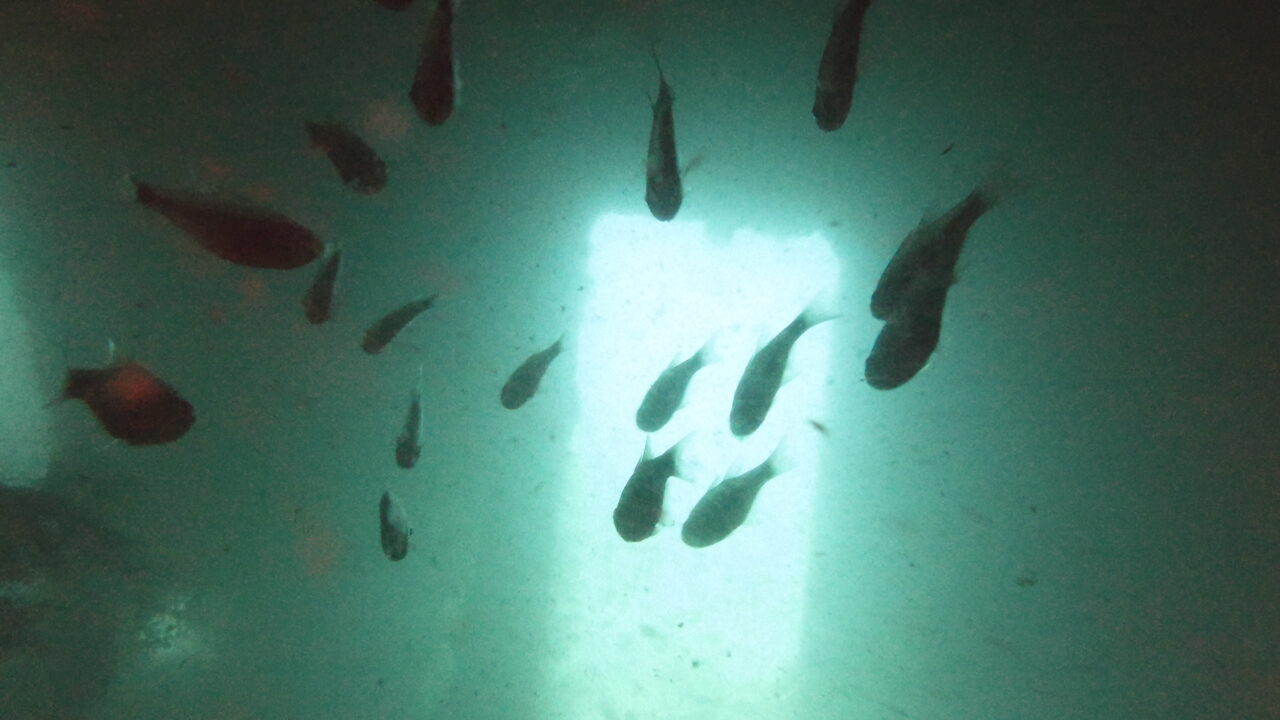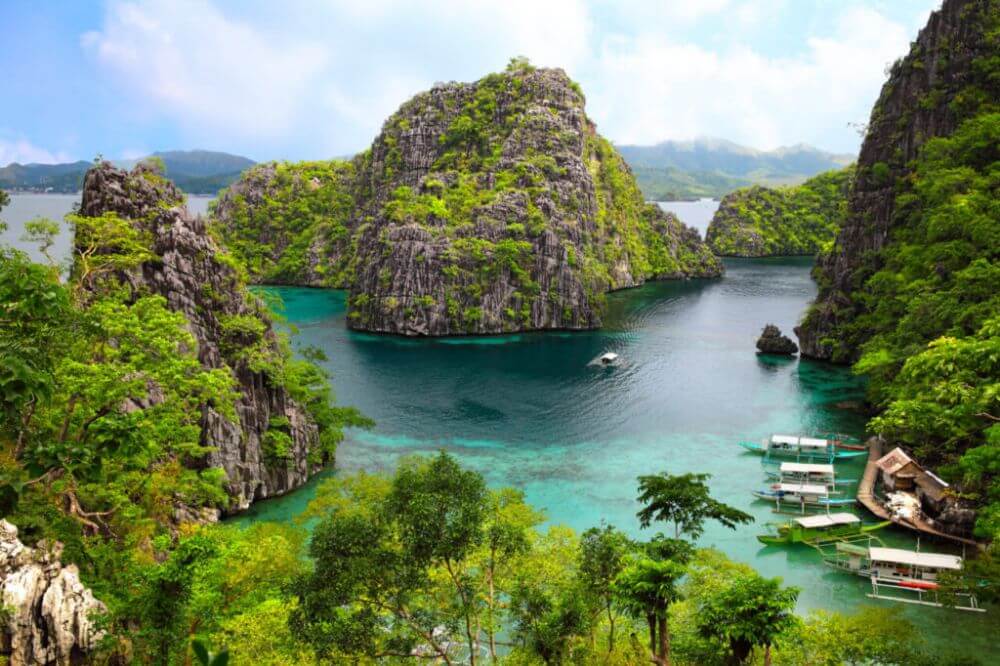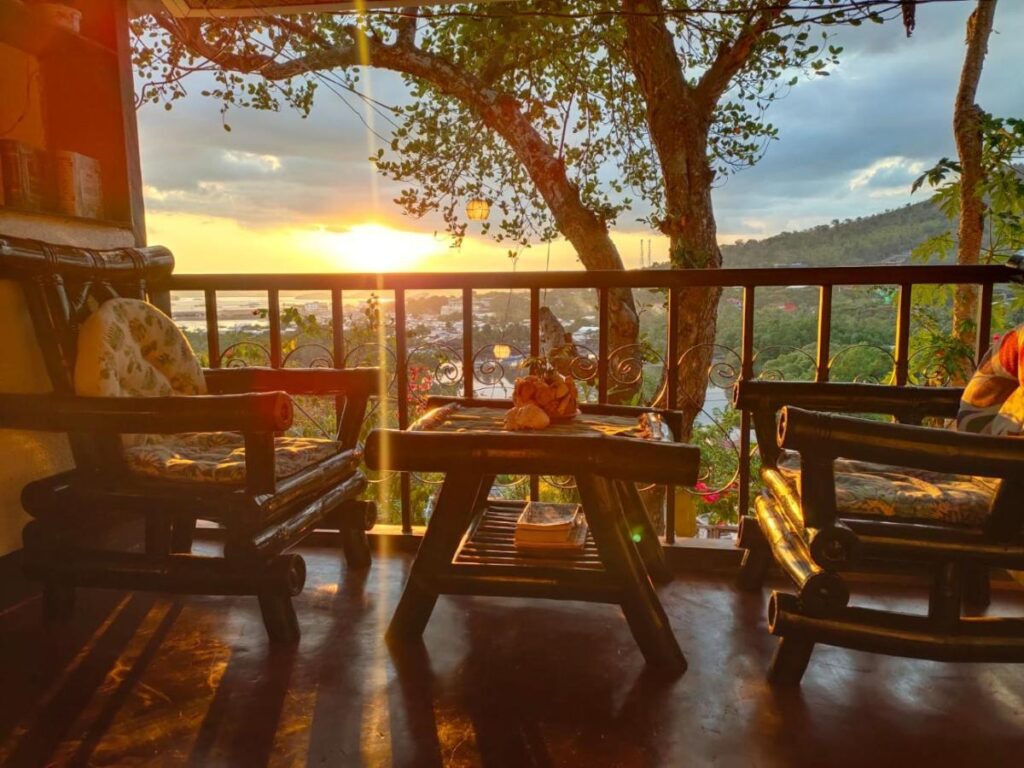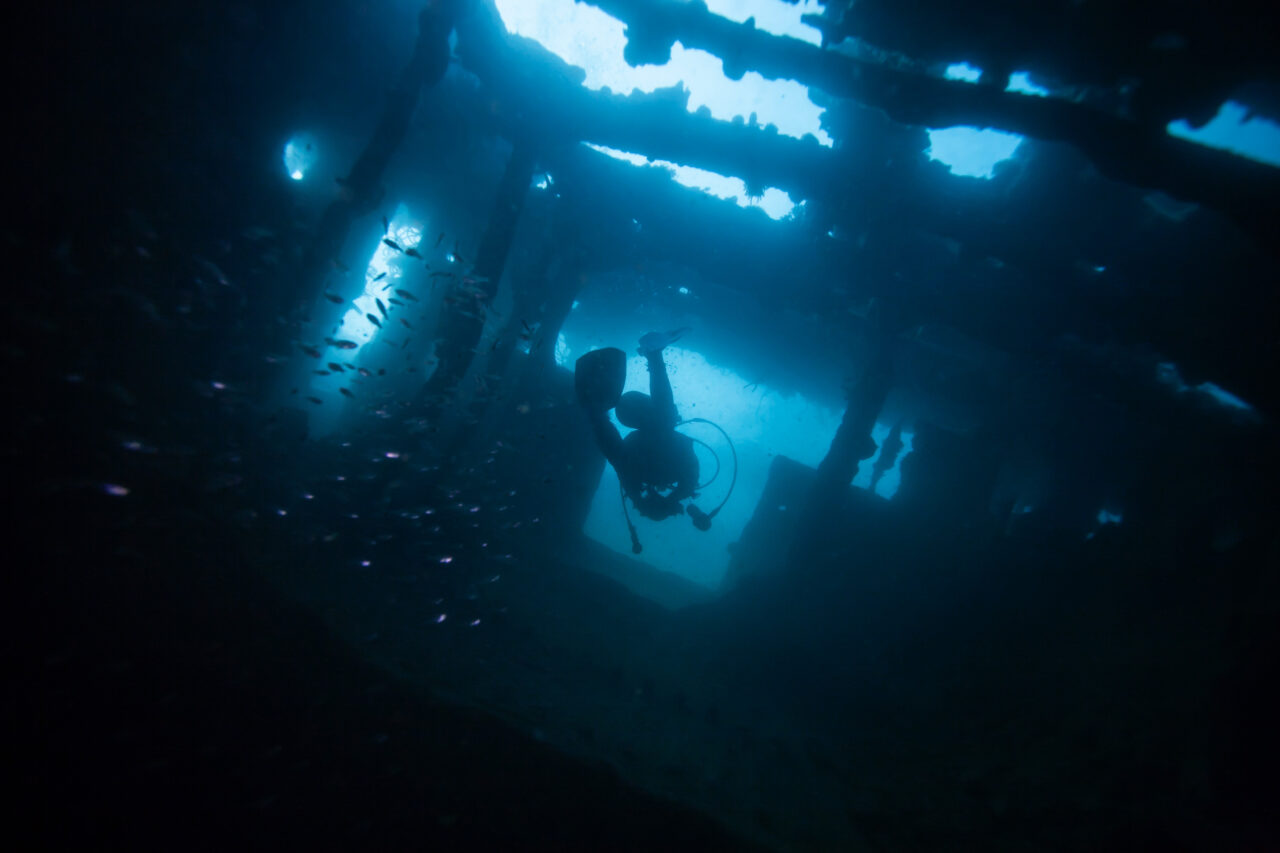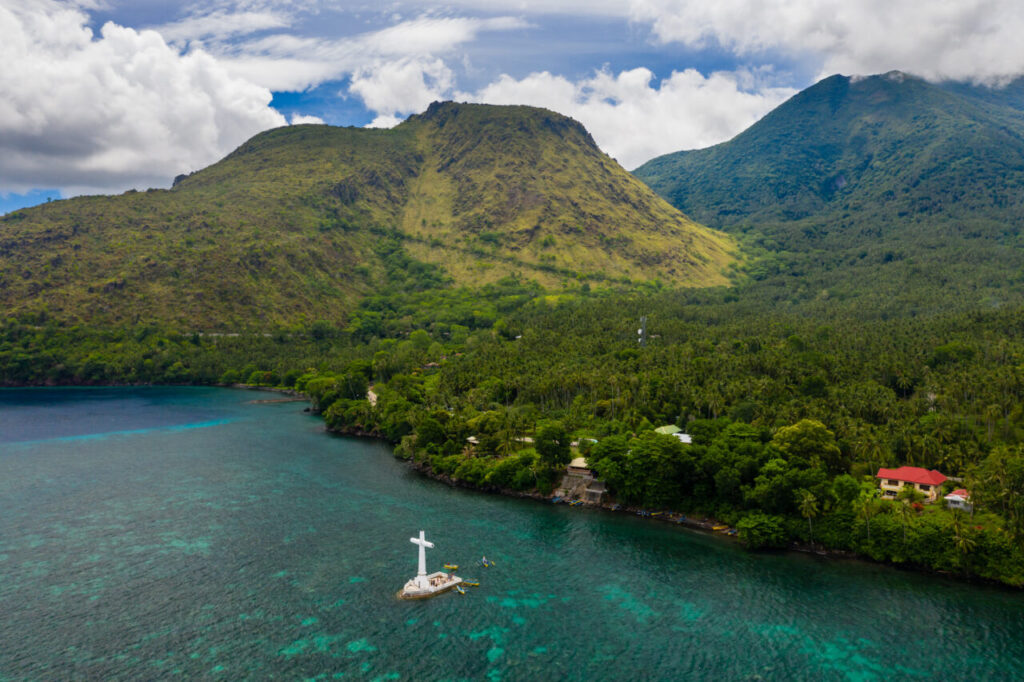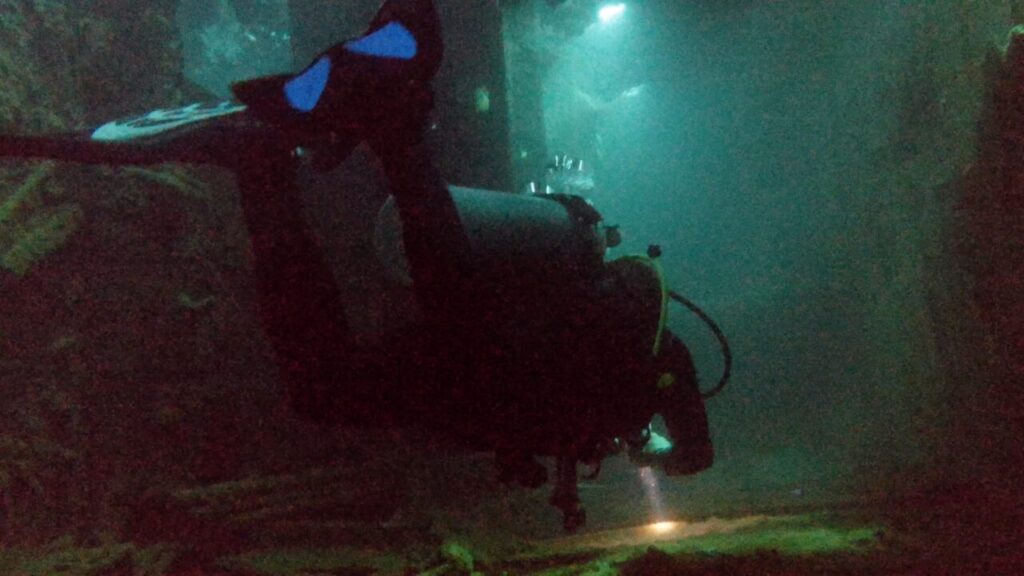
Located at the north tip of the visually-stunning Palawan, Coron is hailed as the best wreck dive destination in not just the Philippines but all of Southeast Asia.
On September 24, 1944 ten Japanese Imperial Navy ships stationed in Coron Bay were sunk by the third air fleet of US Task Force 38.
Lying at depths of 33 – 141 feet (10 – 43 meters) and ranging from 98 – 525 ft (30 – 160 m) in length; these wrecks are encrusted with hard coral on the outside and are home to many fish on the inside.
The larger wrecks take the entire duration of a dive to explore; with many decks, hallways and rooms to drift through and tight gaps to squeeze between that open-out into wide spaces.
Divers can see anti-aircraft guns, boilers, engine rooms and an air-pocket. It is a truly thrilling experience to drift through the vast empty hallways of these wrecks; it feels like a step-back in history.
But do you know which are truly the best wrecks to dive? Or that as well as wreck diving, Coron also has Freshwater Lake diving and even Dugong diving??
That’s why I’ve created this guide; to tell you all you there is to know about diving Coron; based on my own time there in May 2023! After reading this, you’ll be able to dive Coron like a boss!!
(Pssst! I’ve written a separate article about the Best Places to Stay in Coron for Divers. Although that’s briefly covered here, this page is more an informative travel guide for divers in Coron).
Best Coron Dive Sites
There’s a total of 10 shipwrecks in Coron Bay that are accessible to recreational scuba divers. The bigger (and best) ones are for experienced divers… you need to have your advanced open water certification and wreck dive training to do them. Being Nitrox certified is also a huge plus but not essential.
That said, a couple of the wrecks (Teru Kaze Maru & Lusong Gunboat) are fairly small and lie in shallow waters which make them a great option for less experienced divers looking to get their first taste of wreck diving!.
Below, I’ve listed my favourite wreck dives of Coron – but remember more: 10 in total! Dive centres typically make 3 dives a day, so I would try to carve out at least 2 if not 3 days for wreck diving whilst you’re there in order to explore them all.
#1 Morazan Maru
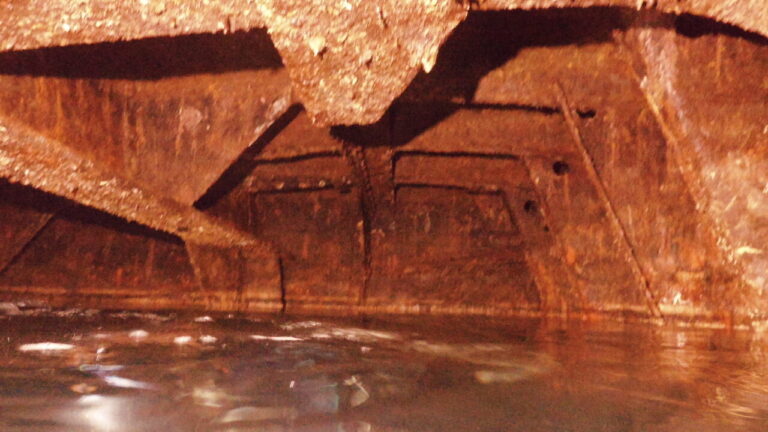
Probably my favourite wreck in all of Coron is the Morazan Maru; an auxiliary cargo vessel that lies at 82ft (25m) deep and which measures 367 feet (111 meters) long.
This wreck is a lot of fun to explore (for advanced open water divers): there are several different routes through it, 4 large and easily penetrable cargo holds, a boiler room and even a room with an air pocket at 65ft (20m) deep, where you can actually stick your head above the water (although keep your reg in your mouth as the air is almost 80 years old!).
There are many large spacious decks in Morazan Maru with big shoals of small silvery fish swimming through them as well as crabs crawling along the walls and portholes allowing beautiful slivers of turquoise light to trickle through. This is an extremely scenic and fun wreck to explore and because there’s several different routes it also has great re-dive value.
#2 Akitsushima Maru
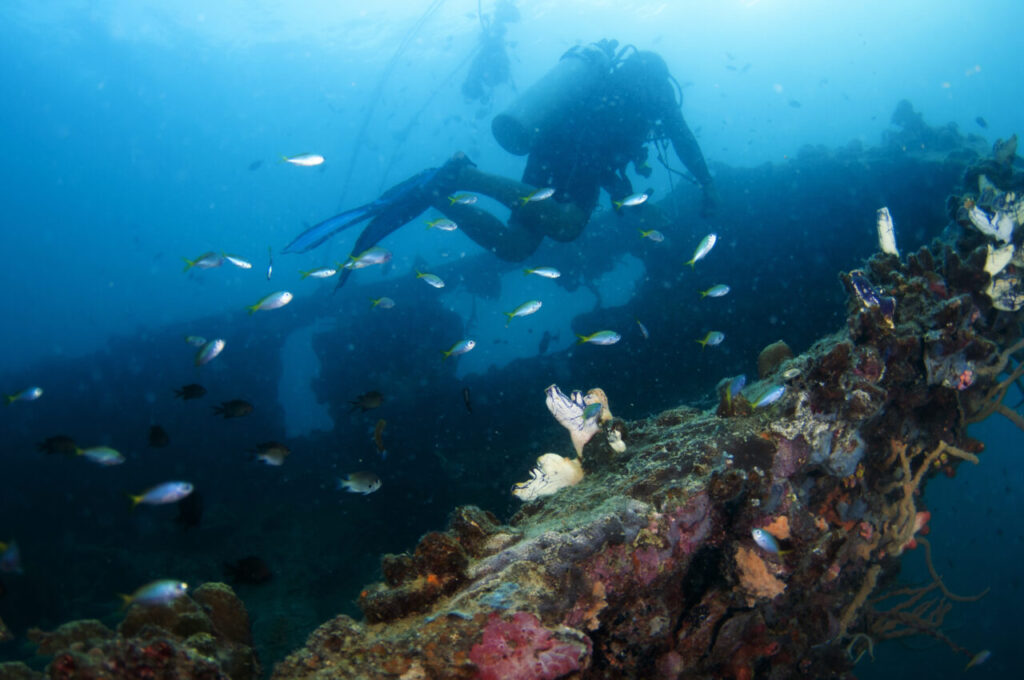
One of the largest and most popular wrecks in Coron, this is the only true “warship” (the rest of the wrecks being auxiliary cargo-ships and the like).
The Akitsushima Maru served to deploy a seaplane from its large crane and deck which now faces sideways as the whole ship lies on its side. This is the only wreck in Coron with any remaining anti-aircraft guns – divers can see several 3-barrelled AA guns at the front of the flying boat tracks!
The starboard hull lies at 72 ft (22 m) deep and the wreck itself measures 289 ft (118 m) long. Penetration is possible for advanced open water divers who can explore several decks as well as the engine room which houses four large diesel engines. In my opinion, the Akitsushima Maru is one of the coolest wrecks in Coron.
#3 Olympia Maru
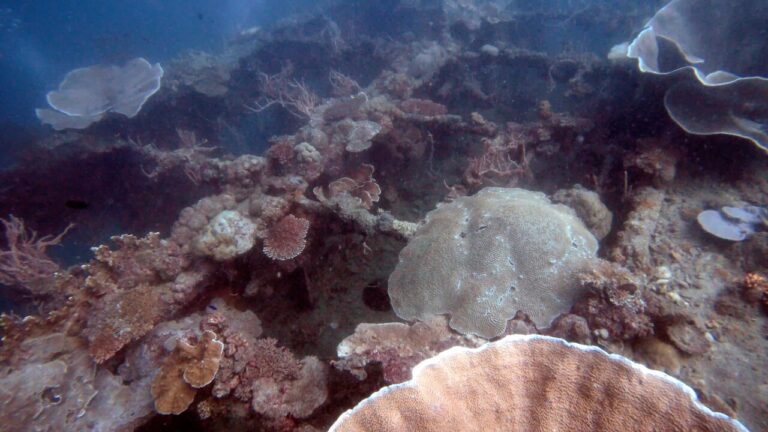
Measuring 305ft (93m) long, the Olympia Maru was an English built (1908) freighter-liner that was seized by the Imperial Japanese Navy in Shanghai in 1941 and then promptly put to use as an auxiliary supply (cargo) vessel.
With its shallowest point lying at just 40ft (12m) in calm conditions and having large, easily accessible penetration points, this is an excellent wreck for those new to wreck diving. That said, it drops down to 82ft / 25m and is a large wreck at 426ft / 130 meters long, meaning there is still a good amount of it to explore for more experienced divers.
#4 Irako
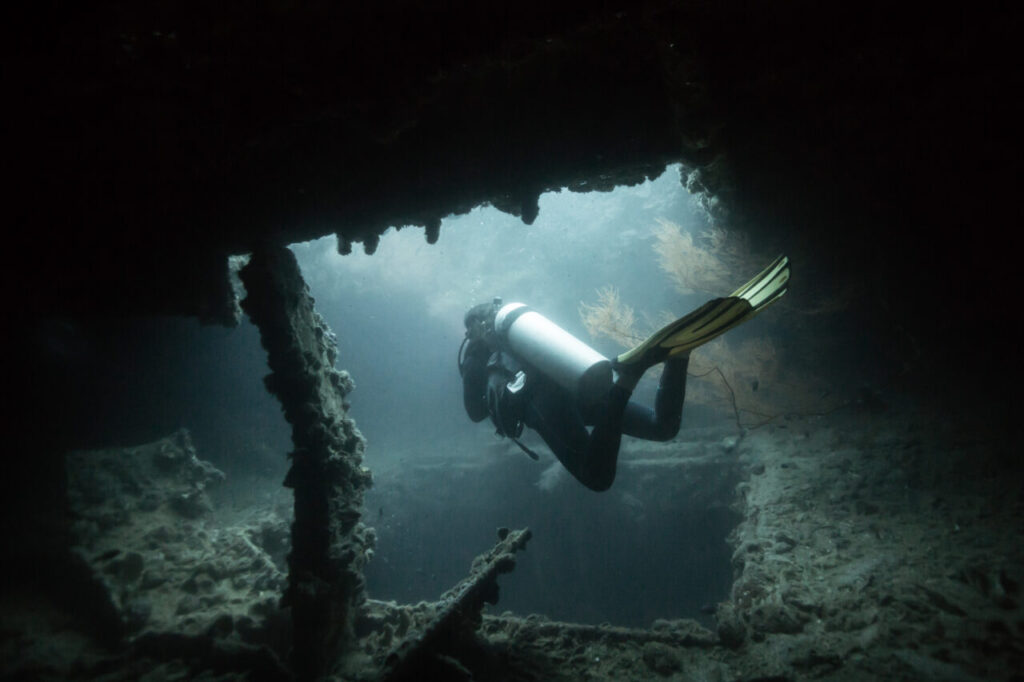
Irako is the most challenging Coron wreck on account of the fact that she has narrow entry points, lies at 108 – 138ft (33-42m) deep and is within an area that sometimes experiences medium to strong currents.
Therefore it is a wreck for confident divers and should ideally be dived on Nitrox. Visibility can be very poor (which it was when I went, hence the lack of photos!); especially if there are multiple divers in the wreck as due to the narrow passageways and small entry points, all it takes is for one moron to kick up a load of silt and you can’t see sh*t!
However, if you’re up for an adventure, Irako is a cool wreck to say you’ve dived – it’s the deepest of all Coron’s (recreational) wreck dives and is both exciting and something of a challenge. You can see an engine room, cargo hold and a transmission room.
#5 Dugong
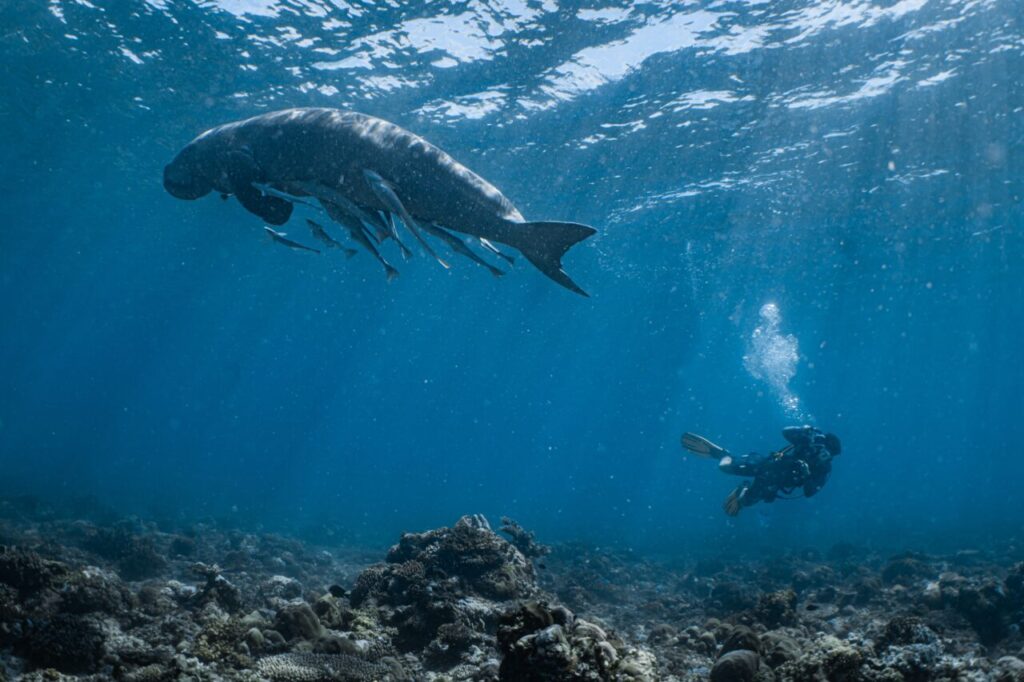
I bet you weren’t expecting Dugong aka Sea Cows to be in Coron! But if you don’t mind a 4am start, a long van ride and a somewhat expensive day (around 10,000 PHP / $180), it’s totally possible to see Dugong around Coron.
This involves travelling to north Busuanga, followed by a 60 minute boat ride to visit known Dugong feeding grounds; where you generally have a 50/50 chance of seeing Dugong (no money back if you don’t!).
Most dive centres (I recommend Umali Dive Centre) can arrange this for you but they require a minimum of 4 people to go.
#6 Barracuda Lake
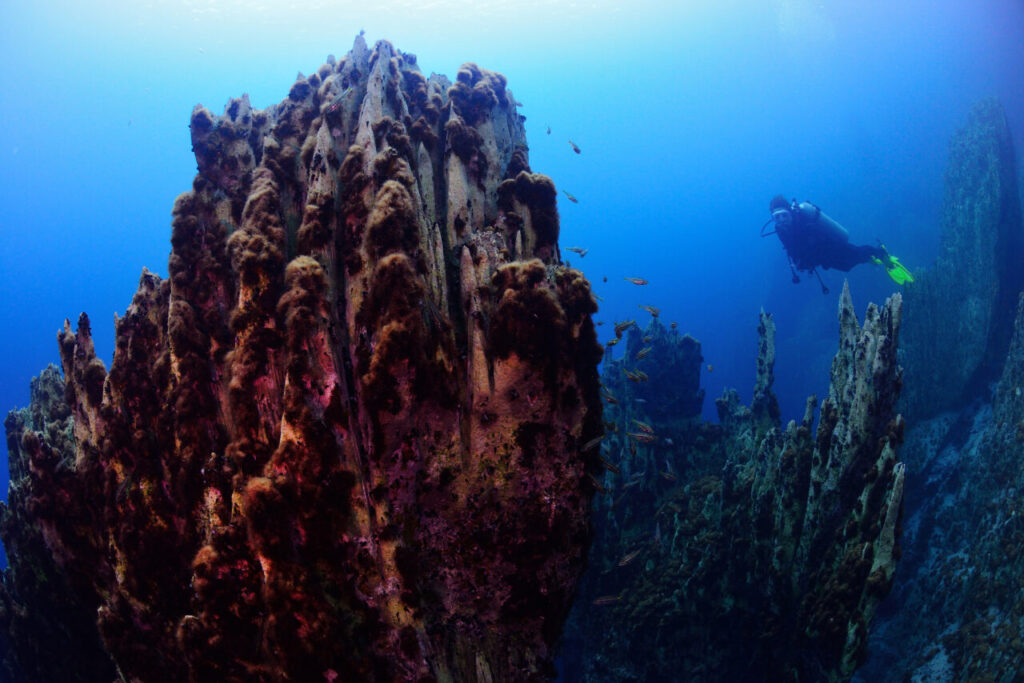
You can also dive Barracuda Lake; a freshwater lake surrounded by epic limestone cliffs. There’s not much animal life to see within the lake but there are some truly incredibly underwater rock formations and a thermocline. Again, ask your dive centre to arrange this for you.
Where to Stay in Coron
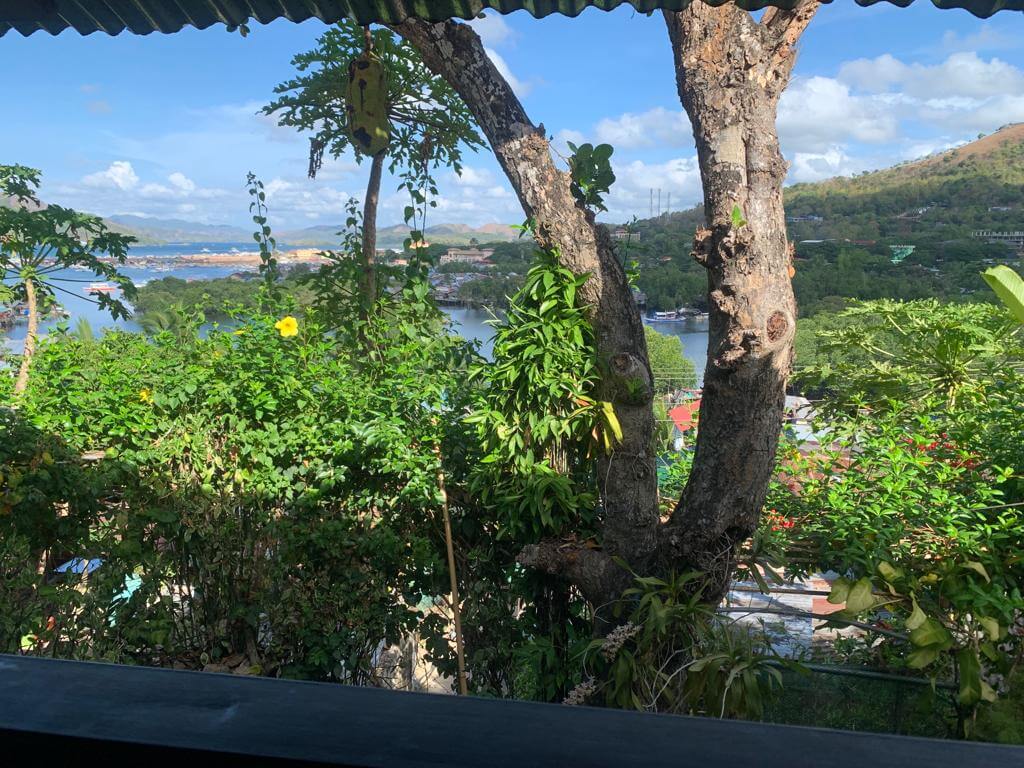
When it comes to choosing where to stay in Coron, you have 2 options:
- Stay in Coron Town: in a hostel or homestay. This is the cheapest option by far and you’ll be near the public dive centres, bars and restaurants as well the busy nightlife. Heads up, Coron town gets super crowded; with heaps of traffic and masses of travellers! It takes around 90 minutes on the boat to reach most wreck dive sites from Coron Town.
- Stay in a Dive Resort: located away from the noisy Coron Town and with it’s own in-house dive centre. Some Coron dive resorts are in very scenic settings and are actually quite a lot closer to the wreck dives meaning less travel time on the boat. This is a much more expensive option.
I’ve written an entire separate article reviewing in-detail the 10 Best Places to stay in Coron for Divers.
Or if you’re short for time, here’s the Top 3 Places to Stay in Coron for Divers:
- Most Luxurious Coron Resort: Chindonan Dive Resort
- Best Cheap Accommodation in Coron Town: Dayon Hostel
- Most Quiet Place to Stay in Coron Town: Purple Homestay
Coron Diving Season
You can dive Coron all year round! That said visibility varies at different times of year:
- December – March: These are usually the months for best visibility on wrecks. If you want to be able to clearly see the entire shipwrecks from the outside, you should aim to go around this period.
- October – June: This is the overall dry period, during which conditions and visibility are more favourable (with December March being the very best months).
- July – September: This is rainy period – during which visibility is the most reduced and water currents can be stronger, which means some of the deeper wrecks may not be possible to dive.
I will say that compared to some other parts of the Philippines, the water visibility in Coron is usually not so good. Only from December – March do you have the chance of vis being high enough to fully see the wrecks from the outside – and this is still not a guarantee. Visibility is generally better before high tide and can be 25 – 66ft (8-20m) but much lower after.
Within the wrecks, visibility is usually good enough to see everything you’re exploring, but again this is not always the case and in the tighter spaces is also dependant on no noobs kicking up loads of silt!
How to Get To Coron
There’s 2 ways to get to Coron:
- Fly into Busuanga (aka Francisco B.) airport and then catch a roughly 50 minute van drive into Coron town. There are direct flights from Manila and Cebu.
- Catch a 5 hour ferry to Coron Port from El Nido which lies further south in Palawan. This is pretty convenient because El Nido has great scuba diving with awesome reefs, sharks and manta rays so you can fit it into your diving itinerary. Ferries run in either direction between El Nido and Coron. Check out El Nido – Coron Ferry Schedules.
Other Things to Do in Coron
Coron is one of the most beautiful parts of the Philippines with mighty limestone cliffs, freshwater lakes, lagoons, beaches and a few other hidden gems. It’s definitely worth taking a day or two to explore Coron in between scuba diving. Here’s some of the other things you can do:
#1 Kayangan Lake
A crystal-clear freshwater lake surrounded by incredible limestone cliffs, you may well recognise Kayangan lake from travel photos as it’s an iconic part of Palawan. Like several of the other sights, I’m about to mention, you can visit it as part of a tour.
I’ll tell you now, that when you go, you will find scores of other tour groups here; there’s usually a couple of hundred travellers in this lake (!) – so go ahead and ditch any goals of using it as a quiet place of solitude – those moments for Kayangan Lake are long gone – but it’s still a kickass sight to behold and the tours are a great way to meet people!
#2 Barracuda Lake

Similar to Kayangan Lake, and so named because of the fact that the huge skeleton of a truly massive barracuda was found here. Some say that every full moon, the bones rise up and it drifts through the water, mouth agape, empty eye-sockets aglow…ok I made that last part up but they really did find the huge skeleton of a giant barracuda here!
In my opinion, barracuda lake is perhaps not quite as impressive as Kayangan lake but it is still very cool to visit and most tours combine both lakes together. You will see many other travellers here as well.
Also, worth noting is that you can scuba dive barracuda lake! There’s little in the way of animal life besides a few shrimp and small fish, however the rock formations are meant to be pretty incredible. There’s also an extreme thermocline in which the water temp abruptly changes from 38 to 28 degrees Celcius which makes for an interesting sensory experience.
#3 Twin Lagoon
Like the lakes, twin lagoons is surrounded by epic towering limestone cliffs with crowns of neon green forest atop. You can swim, kayak (for an extra price), snorkel or even grab a beer from the “floating 7/11” (a dude on a kayak with a cool box containing drinks and snacks). Because it’s saltwater there’s also some pretty nice shallow coral around here.
Once more this is done as part of a tour, which usually includes a visit to the lakes, lagoons and also several beaches and snorkelling sites.
#4 Mount Tapyas Hike
This one you can do on your own. It’s hard to miss Mount Tapayas – it’s the big, 210 meter high hill with the cross atop it in the centre of Coron Town.
Hiking up the viewing deck at the top takes about 20 – 40 minutes (depending on your level of fitness); you have to ascend 700 steps to the top but it offers amazing panoramic views of Coron Town and bay along with other beautiful islands off in the distance. No guide needed. This is best done during sunset for the best red sky view… and to avoid the heat!
#5 Old Abandoned Sea Plane
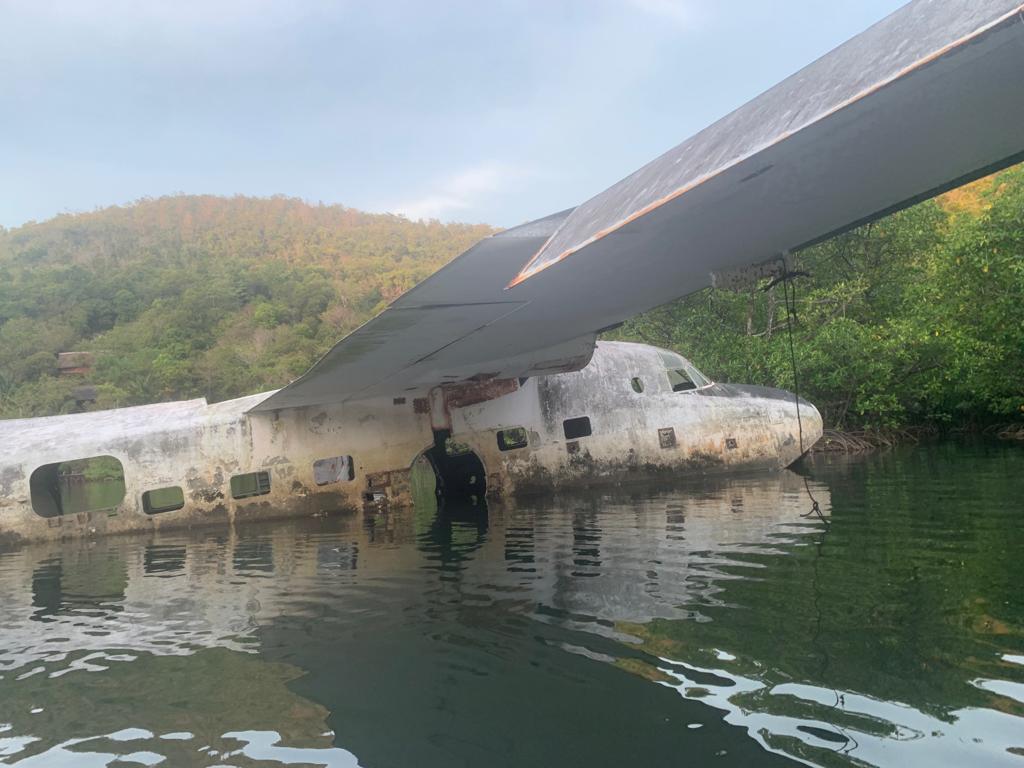
I don’t know what the official name for this is; few people seem to know about it; I only heard of it from a friendly wanderer who appeared out of the blue and whispered top me of its whereabouts.
To get there, to grab a scooter and take the immensely scenic ride out from Coron town for about 35 (if you me) – 60 minutes (if you a sensible driver) to Puerto Del Sol resort. You pay 500 pesos to rent a kayak (and this also gives you something like 200 pesos off any meal or drink you order).
Make your way down the steps to your kayak and head to the seaplane which is just a ten minute paddle away. And there you’ll find the mysterious, partly submerged seaplane. No one knows how it came to be there. It’s been lost in the ages…
At any rate, it’s surrounded by calm waters (but don’t swim, apparently there’s box jellyfish!) and mangrove forest and is a truly chilled place to pass the afternoon. Leave your kayak within the plane (make sure it’s at an angle that it can’t drift out!!!), go into the cockpit and climb up on top here. The tail offers some decent shade from the sun; but still take suncream!
I really enjoyed my time on the seaplane. I spent a whole afternoon there. The first 3 hours it was literally just me; it was a great time to get away from all the fuck*ng noise of so-called civilisation and finally hear my thoughts which were mostly “I want some weed”.
Eventually, the calm ambience came to an abrupt halt when no less than five other travellers turned up at once, complete with a drone, scrambled aboard the plane and proceeded to loudly talk/shout about being in the moment and how to get bigger on social media whilst taking endless selfies. Ah well. Omnia ad finem.
Coron Scuba Diving FAQ
What are Coron Scuba Diving Prices?
Generally, Coron scuba diving prices are no more expensive than other parts of the Philippines, meaning they’re fairly cheap!
However, it’s worth noting that when wreck diving, because the boat has to travel to dive sites for up to an hour, it doesn’t return to the port until completing 3 dives so unless you wanna spend a tedious hour sitting around on the boat, that’s how many you’ll pay for. If I recall correctly, the price of 3 dives is around the 4000 PHP / $72 mark.
The Dugong diving is expensive; 10,000 PHP / $180 for a day of two dives.
Can Beginners Dive the Wrecks of Coron?
A few of the shallow wrecks of the Coron are suitable for beginners like Teru Kaze Maru and Lusong Gunboat.
However, most wrecks are for advanced open water divers with wreck diving training. However, so long as you do have these certifications, you’re good to go – you don’t need to be a grizzled pro with ten years diving under your belt. (Nitrox training is a plus but not essential!).
What are the Highlights of Diving Coron?
Without a doubt, the Japanese Shipwrecks are the highlight of diving Coron. My three personal favourites would have to be Morazan Maru (top fave), Akitsushima (second fave) and Olympia Maru (third fave).
Other notable experiences include Dugong diving (a long day trip and expensive though) and freshwater diving in barracuda lake.
What is the Best Way to do Other Things in Coron?
I heartily recommend signing up for a day tour to see the lakes, lagoon and also various beach hopping and snorkeling spots. Everywhere you go will be crowded, but you’ll meet plenty of other cool travellers and it’s a really fun day out. You can bust out the seaplane and Mount Tapayas yourself in just one day without a guide.
Are there any good Coron Scuba diving packages?
Some dive centres and resorts offer discount packages when you sing up for X number of dives all at once. Or discounts on accommodation when you pair it with diving.
Is there Anything Else I need to Know about Diving Coron?
The best months to go are generally between December – March when visibility is at its best and water conditions at their calmest. If you plan on diving the deeper wrecks, I heartily recommend that you get your Nitrox training – it only takes a day and means you can spend longer in the deeper wrecks! Or you can do your Nitrox training in Coron.
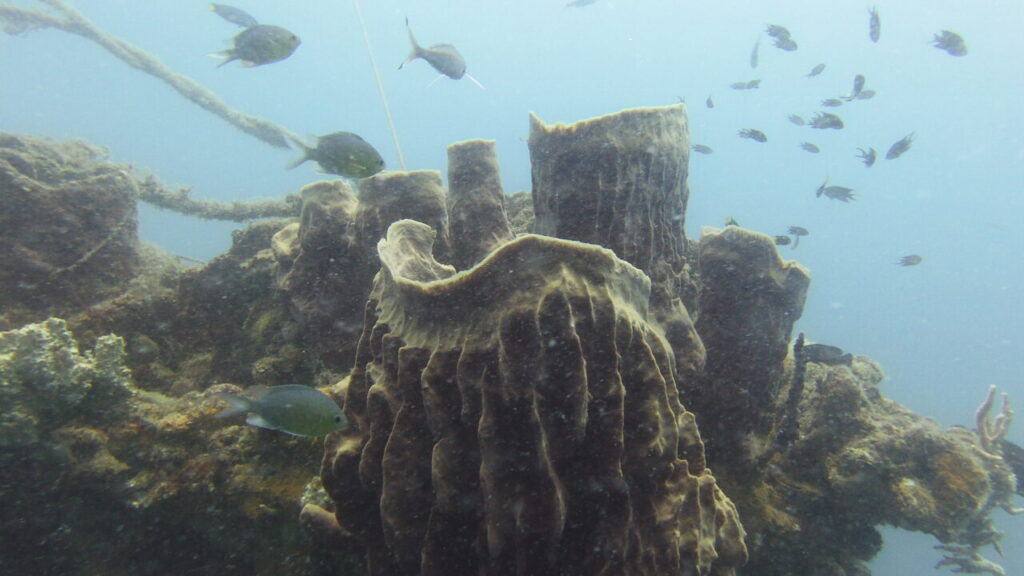
Coron Diving Squad DEBRIEFING:
Looks like you’ve dived all the way down to the Diving Squad dive page on diving Coron. Bloody good diving job!
We’ve covered a lot in this article. First we went over the Best Coron Dive Sites with original photos and videos from my time there in May 2023.
Afterwards we went over the Where to Stay in Coron for Divers, which I’ve written a more detailed guide on here.
Next, we discussed Coron Diving Season then How to Get to Coron and after that a list of the Other Awesome Things to do in Coron.
Finally we rounded off this article with a handy Divers FAQ Section and after the debriefing where we summarise everything that’s been covered – that’s the bit you’re reading now!
I now most heartily recommend that you check out my main page on the Best Places to Stay in Coron for Divers!
By the way! Every time you book accommodation or a ferry ride via an affiliate link on Diving Squad, we’ll make a small yet delicious commission at no extra cost to yourself. Noice! Support like this helps keep Diving Squad ultra awesome, sexy and as the best damn scuba diving blog in the multi-verse – thanks!
It’s also cheaper to book accommodation n advance than it is to pay when you get there – so we’re all winners. Yippee!!
Read Related Content:
